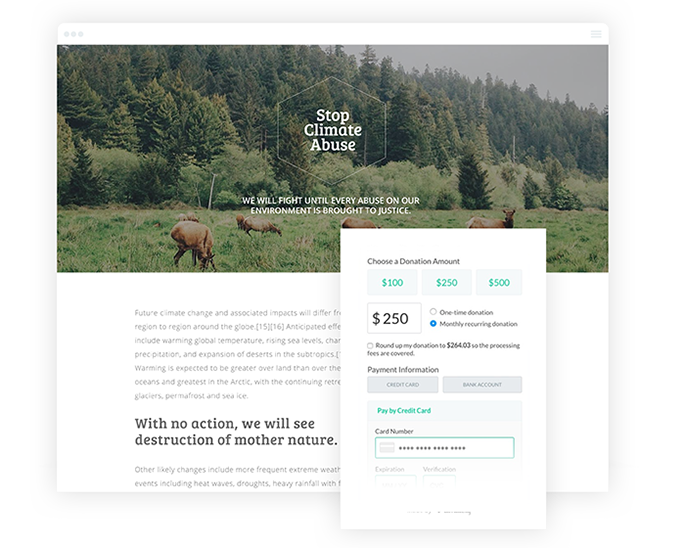Picture this: a supporter encounters a post from their favorite nonprofit while scrolling through their social media feed. They head to the organization’s website to look for a donation page, and the search takes a full minute (practically a lifetime when it comes to internet browsing!). Once they find the form, it’s poorly designed and unclear how to submit a donation. The supporter grows frustrated and ultimately gives up their quest to contribute a gift.
Don’t let this happen to your nonprofit! Your online donation form is a vital piece of your digital fundraising strategy because it is one of the most visible points of connection your organization has with supporters. Optimizing your approach to your online giving page is key to facilitate a better virtual fundraising outcome.
At Donately, more than 2,000 organizations have turned to our online fundraising platform to implement simple changes to their giving pages that make a big difference. You don’t need to be a coding expert to create a strategy that drives better results for your organization. Here are a few of our top donation page tips for greater fundraising success:
- Embed your form on a central page of your nonprofit’s website.
- Include pre-filled donation amounts.
- Promote matching gift opportunities.
- Use your form to gather donor data.
- Encourage continuous involvement.
These strategies will aid in all aspects of your donation form process, from creating the form to marketing your giving opportunities to supporters. Keep in mind that investing in a dedicated online donation platform will help your organization start off on the right foot and simplify the process for your fundraising team and donors. Let’s get started!
1. Embed your form on a central page of your nonprofit’s website.
Since the COVID-19 pandemic forced nonprofits to conduct most fundraising efforts remotely, you probably engage supporters on virtual platforms now more than ever before. One of the most effective ways to stay in touch with your supporters right now is through your nonprofit’s website.
Your website is the hub for all your digital fundraising efforts, and your online giving form is the tool you can use to solicit donations through your site. As described above, you don’t want supporters to have to go on a journey just to figure out how they can give to your cause. Be sure to embed your donation form into an easily-accessible, central page on your website to make it as easy as possible for donors to give. Embedding your donation page into your website will:
- Eliminate donation barriers. When you prominently feature your donation page on your site, supporters can easily access the form and give whenever it’s most convenient for them. Additionally, when your form is responsive to all screens, donors will be able to view and fill out the form whether they’re using a phone, tablet, or computer. Check the formatting of your page on each screen size to ensure it’s optimized for all devices.
- Establish trust. When your donation form is embedded directly into your organization’s website, donors will feel more comfortable submitting their gifts. If donors click on a link to your donation form and are rerouted to a third-party platform, they might feel uneasy and unsure if their donations are going to the right place.
- Build brand recognition. Design your online donation form with your nonprofit’s designated font styles and two to three of your organization’s colors. Then, prominently feature your logo in a corner of the form. By branding your donation form with these elements, you promote cohesion across your digital presence and will effectively enhance brand recognition.
Your ultimate goal is to simplify the path donors take from initial awareness of your nonprofit to deciding to contribute. Use your website to kickstart this process and act as the central information hub for supporters.
2. Include pre-filled donation amounts.
Another strategy to streamline your donation forms is to include suggested donation amounts on your form. For example, you can include several gift amounts for supporters to choose from, such as $100, $250, or $500. Check out this example of a donation form from an environmental justice organization:

Adding pre-filled donation suggestions to your online donation page makes the giving experience much more straightforward for donors. All donors have to do is click their desired option and fill in the rest of their payment information.
These suggestions also help donors figure out how much they should contribute, providing reassurance. When they see a predetermined range of donation options to choose from, they won’t stress about their decision or try to guess how much other supporters give. You can even play around with these numbers by increasing or decreasing your suggestions to see if you can boost your fundraising revenue.
Be sure to look into your options for investing in an online donation platform that can automatically implement these adjustments. According to Donately’s online fundraising guide, your digital fundraising platform should offer customizable form fields. This feature allows you to tailor your fundraising requests to include suggested amounts that your audience will be most receptive to.
3. Promote matching gift opportunities.
What’s better than one donor gift? Two, of course! With matching gift programs, donors can multiply the impact of their contributions. When a company offers this type of program, they’ll match the donations their employees make to eligible nonprofits.
You can use your donation form to connect supporters with information about how to get their donations matched. For example, Double the Donation offers a matching gift search tool you can embed into your donation page, too. Donors can immediately check their eligibility, see the match ratio offered by their company, and access any available matching gift forms.
Although matching gifts are a major fundraising opportunity for your organization, there’s often a lack of knowledge about these programs. Donors may not know that the opportunity even exists, or they may not understand how to complete the necessary forms.
To account for this, be sure to include some information about the basics of these programs and how to cash in on matching opportunities in a pop-up or side-bar section on your form. This page offers a quick rundown on how to use matching gift forms, including the differences between paper and electronic forms. Reference this information as you build out your giving form.
By sharing these resources and tips, your nonprofit can help supporters see how their donations can have an outsized impact on your mission. This will directly boost engagement with your forms.
4. Use your form to gather donor data.
A well-designed donation form can act as more than a channel to collect donations. You can use your donation page to collect comprehensive information about your donors to inform your strategy moving forward.
With your donor dashboard, analyze a few different aspects of your digital fundraising strategy, including:
- Giving trends. Your dashboard can store information about donation trends such as common donation amounts and the most popular days for donations. Perhaps you’ll discover that most people give between $20 – $50 per donation and that Thursday is the top day for giving. With this data, you’ll know you should add suggested gift amounts of $20, $30, and $50 to your form and heavily promote your page on Thursdays.
- Major donors. By storing donor data after every transaction, you can identify your major donors who’ve contributed one or more large gifts. Then, you can focus stewardship efforts on these major donors and craft personalized appreciation messages thanking them for the support. Recognizing donors in this way leads to better donor retention because supporters know how much your organization appreciates their generosity.
- Overall campaign effectiveness. After an intense marketing push or promotional campaign, you can assess donor data to gauge the effectiveness of your strategies and adjust your plans accordingly. For example, perhaps your organization launches an awareness campaign on social media for your Giving Tuesday fundraising event this year. You’ll be able to collect data from this campaign to analyze your results and change up your strategy for the next year for even greater success.
Your donor data can also assist with your prospect research efforts by helping you identify frequent donors who may be interested in strengthening their relationship with your organization. This key fundraising resource allows your organization to maximize its data management efforts to glean new insights that can be used in future campaigns.
5. Encourage continuous involvement.
Lastly, the most effective donation forms don’t just accept one-time donations from supporters. They encourage continuous engagement and connect supporters with additional ways to get involved.
First, offer an opportunity for supporters to turn their single donation into a recurring gift. Check out this example:

As you can see, you can add a multiple choice option for supporters to choose their donation frequency. This way, supporters will be automatically billed monthly, quarterly, annually, or any other regularity. This boosts the convenience of your forms — donors upload their payment information just once, and they can contribute again and again to your cause.
Other ways to use your donation forms to encourage future engagement include:
- Share your social media handles on your thank-you page so donors can stay connected and receive updates on how your organization is using their contributions.
- Ask supporters to sign up for your newsletter to get updates on everything from upcoming volunteer opportunities to virtual events on your calendar.
By offering ways for donors to stay involved with your nonprofit’s activities, you can secure long-term support that helps you exceed your fundraising goals. After all, it’s more cost-effective to maintain the support of recurring donors than to constantly spend time and money to acquire new donors.
With these simple changes, you can give your donation form strategy a comprehensive makeover and help drive better fundraising campaigns. Remember to embed your form into a well-trafficked section of your website, offer multiple ways for supporters to stay involved, and use data to adjust your donation form strategy. You’ll be able to take full advantage of these new giving outlets powered by advanced fundraising technology. Happy fundraising!
Author: Andrew Berry
Andrew is the head of marketing and customer success for Donately. After getting involved with nonprofits at a young age, he discovered a passion for helping the organizations that are making the world a better place. Knowing how vital online fundraising has become, his goal is to help nonprofits raise more money online each year! In his spare time, you will find him cooking up dinner, playing with his dog or cheering on Boston sports teams.
